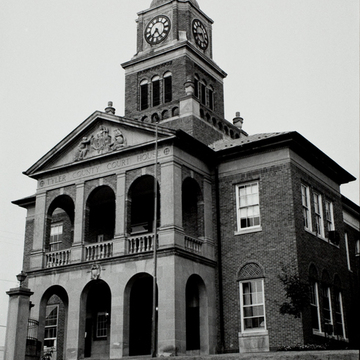As early as 1905, Tyler County sought to replace its 1854 courthouse with a new building. Voters rejected the proposed $60,000 bond issue that would have funded the project, and it was not until 1922 that the issue was again addressed. This time around, county officials decided on a less ambitious approach of remodeling and adding to the building at a cost of $50,000.
A handsome classical frontispiece—a twostory, pedimented portico sheathed in smoothly dressed limestone—contrasts effectively with warm orange tapestry brick walls behind. The portico's first story is treated as an arcade supporting the second level, where stone piers with brick infill arches support a frieze on which the name of the building is inscribed. The pediment contains a sculpted ensemble with a seated figure of Justice impartially dispensing judgments to male and female supplicants urgently begging for mercy. Holmboe and Pogue also added the prominent stone-trimmed brick clock tower that rises from the building's hipped roof behind the portico.
The earlier sheriff's residence and the county jail to the south are physically connected to the courthouse, but they are definitely not linked architecturally. Here, rugged sandstone blocks laid in regular courses and topped with a crenellated parapet convey an appropriate sense of incarceration for those who failed to beg Justice hard enough.

